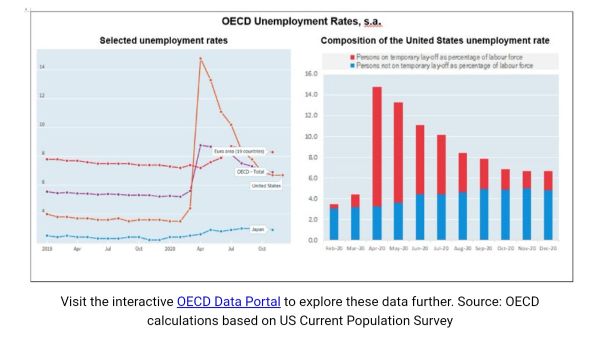OECD Unemployment Rate Further Declines To 6.9% In November 2020
The OECD area unemployment rate continued to decline in November 2020, to 6.9%, from 7.1% in October, but remained 1.7 percentage points above the level observed in February 2020, before the COVID-19 pandemic hit the labour market. It continued to decline faster among women (to 7.0% in November, from 7.2% in October) than among men (to 6.8%, from 6.9%). Similar declines were observed for the youth (aged 15 to 24) (to 14.3%, from 14.4% in October) and for people aged 25 and above (to 6.0%, from 6.1%). 45.5 million persons were unemployed in the OECD area, 10.7 million more than in February.
Some care is needed in interpreting the fall in the OECD area unemployment rate compared to the April peak, as this largely reflects the return of temporary laid-off workers in the United States and Canada, where they are recorded as unemployed.[1]
In November, the unemployment rate in the euro area decreased to 8.3%, from 8.4% in October, but remained 1.1 percentage points above its February level. Declines of 0.3 percentage point or more were observed in Finland, Italy, the Netherlands and Portugal, while increases of 0.2 percentage point or more were registered in France, Ireland and Spain.
In the United States, where the number of people on temporary lay-off declined at a slower pace in November than in previous months, and in Canada, the unemployment rate in November fell by 0.2 and 0.4 percentage point respectively, to 6.7% and 8.5%; in both countries the rate was about three percentage points higher than in February. More recent data for December show that the unemployment rate was stable in the United States (at 6.7%), but increased marginally in Canada (to 8.6%). The November unemployment rate decreased in Japan to 2.9% (from 3.1% in October), remaining higher than in February by 0.5 percentage point. It fell to 15.5% in Colombia (from 16.3% in October), 4.6 percentage points above its level of February. Marginal declines were observed in Mexico (to 4.5%) and Korea (to 4.1%).
It should be noted that unemployment statistics do not account for the full amount of labour market slack due to Covid-19, as some non-employed persons may be classified as “out of the labour force” because, due to the pandemic, they are either not able to actively look for a job or are not available to work.[2]
See the full release.
See the tables and charts in Excel.

[1] For Canada and the United States, the statistical treatment of persons on temporary layoff is different from other countries, where these persons are typically recorded as employed. See the note on the divergence in employment and unemployment statistics during the Covid-19 crisis on next page.
[2] The ILO guidelines define the unemployed as “all those of working age who were not in employment, carried out activities to seek employment during a specified recent period and were currently available to take up employment given a job opportunity”. Some not-employed persons may be classified as “inactive/out of the labour force” because, due to the pandemic, they are either not able to actively look for a job even if they are available to work or are not available to work because of family responsibilities as schools and care services are closed.


 John P. Ruehl, IMI: What Will Tech Moguls Do With Their Wealth?
John P. Ruehl, IMI: What Will Tech Moguls Do With Their Wealth? ITUC: Workers Must Not Pay The Price Of An Imposed Trade War
ITUC: Workers Must Not Pay The Price Of An Imposed Trade War Greenpeace: Major Deep Sea Mining Company Goes Bankrupt
Greenpeace: Major Deep Sea Mining Company Goes Bankrupt New Zealand Defence Force: Indian And New Zealand Navies Involved In $181m Drug Bust In Indian Ocean
New Zealand Defence Force: Indian And New Zealand Navies Involved In $181m Drug Bust In Indian Ocean Google Cloud Security: North Korea’s Expanding IT Threat - NZ And Other Nations In The Crosshairs
Google Cloud Security: North Korea’s Expanding IT Threat - NZ And Other Nations In The Crosshairs ICHRP: ICHRP Condemns Harassment And Threats Against Victims Of Duterte’s War On The Poor
ICHRP: ICHRP Condemns Harassment And Threats Against Victims Of Duterte’s War On The Poor